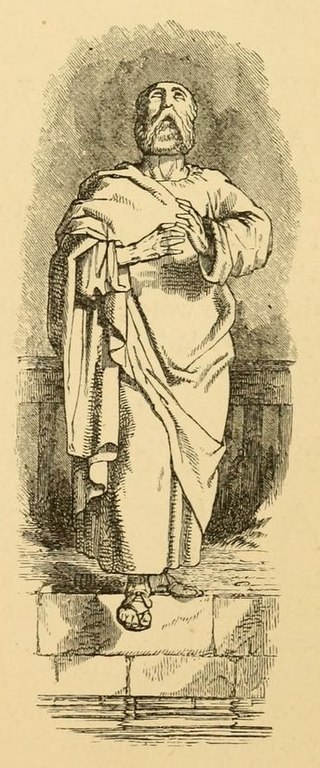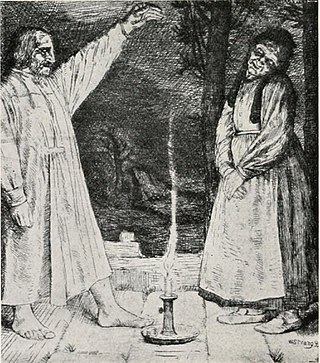
The Panchatantra is an ancient Indian collection of interrelated animal fables in Sanskrit verse and prose, arranged within a frame story. The surviving work is dated to about 200 BCE, but the fables are likely much more ancient. The text's author is unknown, but it has been attributed to Vishnu Sharma in some recensions and Vasubhaga in others, both of which may be fictitious pen names. It is likely a Hindu text, and based on older oral traditions with "animal fables that are as old as we are able to imagine".

Aesop's Fables, or the Aesopica, is a collection of fables credited to Aesop, a slave and storyteller who lived in ancient Greece between 620 and 564 BCE. Of diverse origins, the stories associated with his name have descended to modern times through a number of sources and continue to be reinterpreted in different verbal registers and in popular as well as artistic media.

Robert Henryson was a poet who flourished in Scotland in the period c. 1460–1500. Counted among the Scots makars, he lived in the royal burgh of Dunfermline and is a distinctive voice in the Northern Renaissance at a time when the culture was on a cusp between medieval and renaissance sensibilities. Little is known of his life, but evidence suggests that he was a teacher who had training in law and the humanities, that he had a connection with Dunfermline Abbey and that he may also have been associated for a period with Glasgow University. His poetry was composed in Middle Scots at a time when this was the state language. His writing consists mainly of narrative works. His surviving body of work amounts to almost 5000 lines.

The Boy Who Cried Wolf is one of Aesop's Fables, numbered 210 in the Perry Index. From it is derived the English idiom "to cry wolf", defined as "to give a false alarm" in eBrewer's Dictionary of Phrase and Fable and glossed by the Oxford English Dictionary as meaning to make false claims, with the result that subsequent true claims are disbelieved.

Fables is an American comic book series created and written by Bill Willingham, published by DC Comics' Vertigo imprint. Willingham served as sole writer for its entirety, with Mark Buckingham penciling more than 110 issues. The series featured various other pencillers over the years, most notably Lan Medina and Steve Leialoha. Fables was launched in July 2002 and concluded in July 2015. In June 2021, it was announced that Fables would be getting revived in 2022 with a 12-issue continuation to the main series, as well as a 6-issue spinoff miniseries Batman vs. Bigby! A Wolf in Gotham, both published under DC Black Label.

Wise Men of Gotham is the early name given to the people of the village of Gotham, Nottinghamshire, in allusion to an incident where they supposedly feigned idiocy to avoid a Royal visit.
"Markheim" is a short story by Robert Louis Stevenson, originally prepared for the Pall Mall Gazette in 1884, but published in 1885 in The Broken Shaft: Tales of Mid-Ocean as part of Unwin's Christmas Annual. The story was later published in Stevenson's collection The Merry Men and Other Tales and Fables (1887).
Chanticleer and the Fox is a fable that dates from the Middle Ages. Though it can be compared to Aesop's fable of The Fox and the Crow, it is of more recent origin. The story became well known in Europe because of its connection with several popular literary works and was eventually recorded in collections of Aesop's Fables from the time of Heinrich Steinhowel and William Caxton onwards. It is numbered 562 in the Perry Index.
"The Merry Men" is a short story by Robert Louis Stevenson first published in 1882 in Cornhill Magazine 45-6. The story was later published in Stevenson's collection The Merry Men and Other Tales and Fables (1887). It is set on the fictional island Eilean Aros, based on the Isle of Erraid. The title derives from the local name given to a group of waves in the story, not from the Merry Men of Robin Hood and his merry men
The Bear and the Gardener is a fable of eastern origin that warns against making foolish friendships. There are several variant versions, both literary and oral, across the world and its folk elements are classed as Aarne-Thompson-Uther type 1586. The La Fontaine version has been taken as demonstrating various philosophical lessons.

Robin Hood is a fictional character, a comic book outlaw published by DC Comics. Robin Hood debuted in New Adventure Comics vol. 1 #23, and was created by Sven Elven. The character is based on the legendary archer Robin Hood whose earliest recorded literary appearance was in William Langland's 14th century narrative poem, Piers Plowman. The character of Robin Hood was made popular by Howard Pyle's 19th century novel The Merry Adventures of Robin Hood.

Samuel Langhorne Clemens , well known by his pen name Mark Twain, was an American author and humorist. Twain is noted for his novels Adventures of Huckleberry Finn (1884), which has been called the "Great American Novel," and The Adventures of Tom Sawyer (1876). He also wrote poetry, short stories, essays, and non-fiction. His big break was "The Celebrated Jumping Frog of Calaveras County" (1867).

The miller, his son and the donkey is a widely dispersed fable, number 721 in the Perry Index and number 1215 in the Aarne–Thompson classification systems of folklore narratives. Though it may have ancient analogues, the earliest extant version is in the work of the 13th-century Arab writer Ibn Said. There are many eastern versions of the tale and in Europe it was included in a number of Mediaeval collections. Since then it has been frequently included in collections of Aesop's fables as well as the influential Fables of Jean de la Fontaine.
The drowned woman and her husband is a story found in Mediaeval jest-books that entered the fable tradition in the 16th century. It was occasionally included in collections of Aesop's Fables but never became established as such and has no number in the Perry Index. Folk variants in which a contrary wife is sought upstream by her husband after she drowns are catalogued under the Aarne-Thompson classification system as type 1365A.
The title of Shakespeare's Jest Book has been given to two quite different early Tudor period collections of humorous anecdotes, published within a few years of each other. The first was The Hundred Merry Tales, the only surviving complete edition of which was published in 1526. The other, published about 1530, was titled Merry Tales and Quick Answers and originally contained 113 stories. An augmented edition of 1564 contained 140.
The Old Woman and the Doctor is a story of Greek origin that was included among Aesop's Fables and later in the 4th century CE joke book, the Philogelos. It is numbered 57 in the Perry Index.

"The Astrologer who Fell into a Well" is a fable based on a Greek anecdote concerning the pre-Socratic philosopher Thales of Miletus. It was one of several ancient jokes that were absorbed into Aesop's Fables and is now numbered 40 in the Perry Index. During the scientific attack on astrology in the 16th–17th centuries, the story again became very popular.

The Assand his Masters is a fable that has also gone by the alternative titles The ass and the gardener and Jupiter and the ass. Included among Aesop's Fables, it is numbered 179 in the Perry Index.
The Merry Men are a group of legendary outlaws associated with Robin Hood.

"Thrawn Janet" is a short story, written in Scots, by the Scottish author Robert Louis Stevenson. He wrote the story in the summer of 1881 while he stayed at the rented Kinnaird Cottage in Kinnaird, a hamlet near Pitlochry, with his parents and wife. When he read the story to his wife Fanny Stevenson, she said of it that it "sent a cauld grue [shudder] along my bones" and "fair frightened" Stevenson himself. It was first published in the October 1881 issue of the Cornhill Magazine. It is a dark tale of satanic possession.












